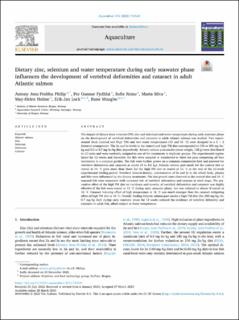| dc.contributor.author | Philip, Antony Jesu Prabhu | |
| dc.contributor.author | Fjelldal, Per Gunnar | |
| dc.contributor.author | Remø, Sofie C. | |
| dc.contributor.author | Silva, Marta Sofia | |
| dc.contributor.author | Holme, May-Helen | |
| dc.contributor.author | Lock, Erik Jan Robert | |
| dc.contributor.author | Waagbø, Rune | |
| dc.date.accessioned | 2023-08-10T12:49:34Z | |
| dc.date.available | 2023-08-10T12:49:34Z | |
| dc.date.created | 2023-04-12T16:49:26Z | |
| dc.date.issued | 2023 | |
| dc.identifier.issn | 0044-8486 | |
| dc.identifier.uri | https://hdl.handle.net/11250/3083391 | |
| dc.description.abstract | The impact of dietary trace minerals (TM; zinc and selenium) and water temperature during early seawater phase on the development of vertebral deformities and cataracts in adult Atlantic salmon was studied. Two experimental feeds (control and High TM) and two water temperatures (12 and 16 °C) were designed in a 2 × 2 factorial arrangement. The Zn and Se levels in the control and high TM diet corresponded to 150 or 200 mg Zn/kg and 0.5 or 0.7 mg Se/kg diet, respectively. Atlantic salmon post-smolts (mean weight, 138 g) were distributed in 12 tanks and were randomly assigned to one of the treatments in triplicate groups. The experimental regime lasted for 12 weeks and thereafter the fish were sampled or transferred to three net pens comprising all four treatments in a common garden. The fish were further grown on a common commercial feed and assessed for vertebral deformities and cataracts as adults (4 to 4.5 kg). Atlantic salmon post-smolt fed the control diet or reared at 16 °C grew more than those fed the high TM diet or reared at 12 °C at the end of the 12-week experimental feeding period. Vertebral mineral density, concentration of Zn and Se in the whole body, plasma and bile were influenced by the dietary treatments. The fast growth rates observed in the control diet and 16 °C exposed fish were associated with increased risk of vertebral deformities and cataract at adult stage. The preventive effect of the high TM diet on incidence and severity of vertebral deformities and cataracts was highly effective if the fish were reared at 12 °C during early seawater phase, but was reduced or absent if reared at 16 °C. Cataract inducing effect of high temperature at 16 °C was much stronger than the cataract mitigating effect of high TM diet at 16 °C. Overall, feeding Atlantic salmon post-smolts a high TM diet (Zn: 200 mg/kg; Se: 0.7 mg/kg diet) during early seawater phase for 12 weeks reduced the incidence of vertebral deformity and cataracts in adult fish, albeit subject to water temperature. | en_US |
| dc.language.iso | eng | en_US |
| dc.publisher | Elsevier | en_US |
| dc.rights | Navngivelse 4.0 Internasjonal | * |
| dc.rights.uri | http://creativecommons.org/licenses/by/4.0/deed.no | * |
| dc.title | Dietary zinc, selenium and water temperature during early seawater phase influences the development of vertebral deformities and cataract in adult Atlantic salmon | en_US |
| dc.type | Journal article | en_US |
| dc.type | Peer reviewed | en_US |
| dc.description.version | publishedVersion | en_US |
| dc.rights.holder | Copyright 2023 The Authors | en_US |
| dc.source.articlenumber | 739529 | en_US |
| cristin.ispublished | true | |
| cristin.fulltext | original | |
| cristin.qualitycode | 2 | |
| dc.identifier.doi | 10.1016/j.aquaculture.2023.739529 | |
| dc.identifier.cristin | 2140391 | |
| dc.source.journal | Aquaculture | en_US |
| dc.identifier.citation | Aquaculture. 2023, 572, 739529. | en_US |
| dc.source.volume | 572 | en_US |

